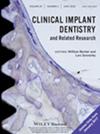Effect of immediate all-digital restoration of single posterior implants: The SafetyCrown concept on patient-reported outcome measures, accuracy, and treatment time—A randomized clinical trial
Abstract
Objective
The SafetyCrown workflow facilitates the immediate restoration of posterior single sites with the one-abutment/one-time concept. This randomized clinical trial aimed to assess the direct effect of immediate restoration on dental patient-reported outcomes (dPROs), feasibility, implant accuracy, and time.
Materials and Methods
Participants with a single posterior edentulous site for late implant placement underwent optical impressions, shade selection, and cone beam computed tomography. After virtual treatment planning, they were randomized into the test group and the control group. For the test group, individual definitive hybrid abutments were prefabricated. The next step was a fully guided surgery with printed guides. After the implant was placed using guided surgery, the abutment was inserted. A chairside CAD/CAM workflow was used to provide the patient with a provisional restoration. Implants in the control group were left submerged to heal. Oral health-related quality of life (OHRQoL) was assessed using the OHIP-G14, and dPRO was measured using a 10-item visual analog scale (VAS) questionnaire. Additional measurements of implant accuracy and time were performed. Follow-up was performed 7 to 10 days after implant placement.
Results
Thirty-nine participants with 45 restorations were included (test group: 23, control: 22). Immediate restoration was successful in 21 out of 23 implants (91.3%) in the test group. Both groups exhibited decreased OHRQoL without significant intergroup differences, while patient satisfaction was high overall. Test group participants perceived higher benefits and satisfaction with immediate loading than participants in the control group. Implant accuracy averaged 0.60 mm at the shoulder and 0.95 mm at the apex. Operative time was longer in the immediate loading group (61.9 min) than in the control group (32.1 min) (p < 0.001).
Conclusions
Considering the limitations, the immediate restoration of late placed posterior implants using the described workflow proved feasible in 21 out of 23 cases. Both groups achieved high patient satisfaction with no differences in OHRQoL during the first week. Patients who received immediate loading rated the benefits very highly and were satisfied with the provisional restoration during the healing period.


 求助内容:
求助内容: 应助结果提醒方式:
应助结果提醒方式:


